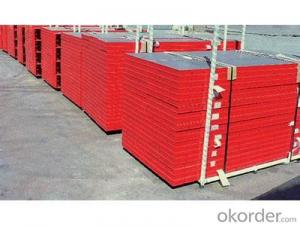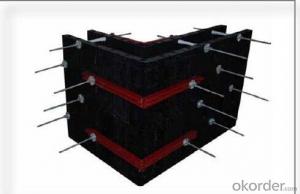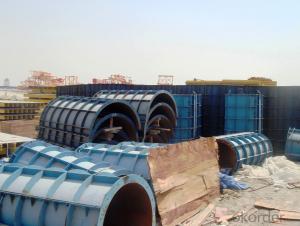Tabel formwork System
- Loading Port:
- China Main Port
- Payment Terms:
- TT OR LC
- Min Order Qty:
- -
- Supply Capability:
- -
OKorder Service Pledge
Quality Product, Order Online Tracking, Timely Delivery
OKorder Financial Service
Credit Rating, Credit Services, Credit Purchasing
You Might Also Like
Tabel Formwork:
Table formwork is the most typical application for slab, with timber beam, the slab formwork is
light weight, fast and economic in the construction.
Characteristics:
◆ Simple structure, easy assembly.
◆ Flexible structure, be adapted to different support system.
◆ High construction efficiency with special system tools.
1. Lifting fork for lifting the table formwork to upper floor.
2. Trolley for moving the table formwork on floor.
◆ Flexible application with stand alone props.
◆ Safer condition with handrails.
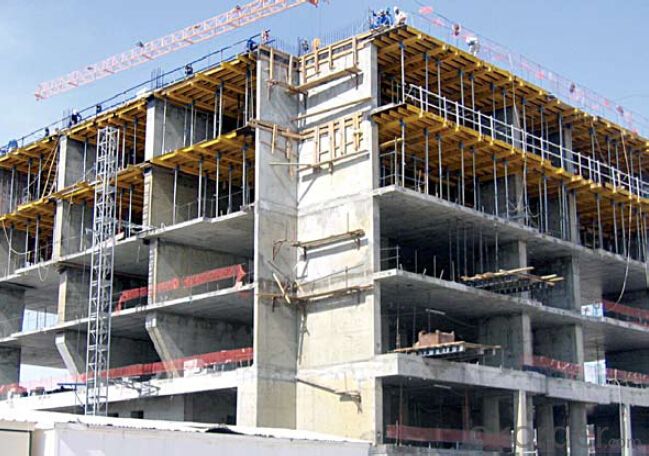
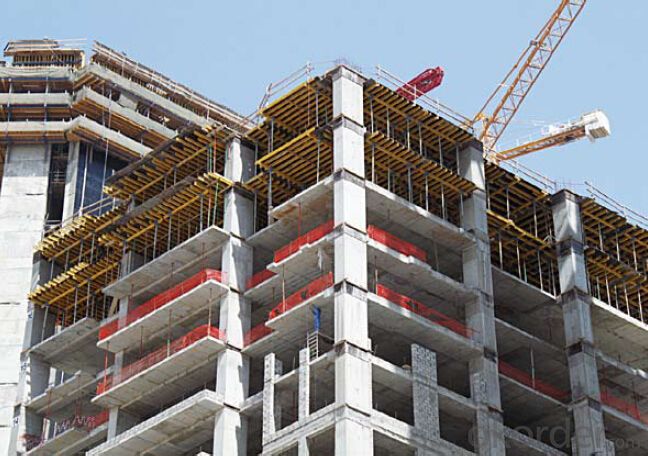

- Q:Does steel frame formwork require any specific lifting or hoisting equipment?
- Yes, steel frame formwork typically requires specific lifting or hoisting equipment such as cranes or forklifts to safely lift and position the heavy steel frames into place.
- Q:What type of concrete finishes can be achieved with steel frame formwork?
- Steel frame formwork offers versatility and durability, making it capable of producing various concrete finishes. This formwork system enables the creation of smooth, textured, and decorative finishes. Smooth finishes are commonly achieved using steel frame formwork. The rigid steel frames ensure that the concrete is poured and compacted evenly, resulting in a smooth and uniform surface. This finish is ideal for areas that require a clean and polished appearance, such as walls, ceilings, and floors. In addition to smooth finishes, steel frame formwork can also be utilized to create textured finishes. By incorporating different patterns or textures onto the surface of the formwork, the concrete can be cast with a textured finish. This includes patterns like brickwork or wood grain, providing aesthetic enhancement to architectural elements like facades, columns, or decorative walls. Moreover, steel frame formwork facilitates the creation of decorative finishes. These finishes involve adding special coatings, pigments, or aggregates to the concrete mix to achieve a desired appearance. The steel frames provide the necessary support for intricate designs, shapes, or patterns. Decorative finishes are commonly used in high-end projects such as museums, galleries, or luxury residences, where aesthetics are of great importance. In conclusion, steel frame formwork offers a wide range of possibilities for concrete finishes. Whether it be smooth and even surfaces or textured and decorative finishes, this formwork system provides the necessary support and flexibility to meet various design requirements.
- Q:How does steel frame formwork handle the pouring and curing of concrete in extreme temperatures?
- Steel frame formwork is highly durable and can effectively handle the pouring and curing of concrete in extreme temperatures. The steel material used in the formwork is resistant to high heat, ensuring that it remains structurally stable and does not warp or deform during the concrete pouring process. Additionally, the steel frame provides excellent support and stability to the concrete, preventing any potential issues caused by temperature fluctuations. Overall, steel frame formwork is reliable and enables the pouring and curing of concrete even in extreme temperature conditions.
- Q:What are the maintenance requirements for steel frame formwork?
- The maintenance requirements for steel frame formwork involve several key aspects to ensure its optimal performance and longevity. First and foremost, regular cleaning is essential to remove any debris, concrete residue, or other materials that may accumulate on the steel frames. This can be done using water and mild detergent, followed by thorough drying to prevent rust formation. It is important to inspect the frames for any signs of corrosion or damage during the cleaning process. Additionally, lubrication of moving parts, such as hinges, joints, and locking mechanisms, is necessary to prevent friction and ensure smooth operation. Applying a suitable lubricant, such as silicone spray or grease, will help to prolong the lifespan of these components. Furthermore, the steel frame formwork should be stored in a dry and well-ventilated area when not in use. This helps to prevent moisture buildup, which can lead to rusting and degradation of the steel. It is advisable to keep the formwork elevated off the ground and protected from direct exposure to sunlight and extreme weather conditions, as these can also contribute to its deterioration. Regular inspections are crucial in identifying any signs of wear and tear, such as cracks, bent or misaligned parts, or loose connections. Any damaged or faulty components should be repaired or replaced promptly to maintain the formwork's structural integrity and safety. Lastly, proper handling and storage practices should be followed to prevent any accidental damage during transportation or when not in use. This includes avoiding excessive stacking, dropping, or mishandling of the steel frames. By adhering to these maintenance requirements, the steel frame formwork can be effectively preserved and continue to deliver reliable performance throughout its lifespan.
- Q:PKPM how to add lateral restraint steel frame
- There are many ways to increase the number of constraints, such as adding beams, adding steel columns, or increasing the size of some of the components, the increase in the stiffness of the floor, the stiffness increases the constraint is also relative to increase
- Q:Can steel frame formwork be used for both insulated and non-insulated wall construction?
- Both insulated and non-insulated wall construction can utilize steel frame formwork. Steel frame formwork is a system of temporary molds or structures that hold concrete in place during construction. These versatile formwork systems can be adjusted to meet various construction needs, including insulated and non-insulated wall construction. When constructing insulated walls, steel frame formwork can be used to create a mold that incorporates insulation materials, like foam boards or panels. Additional features like channels or slots can be included in the formwork system to securely hold the insulation in place. Concrete is then poured into the formwork, encasing the insulation and resulting in a durable and insulated wall. For non-insulated wall construction, steel frame formwork is similarly employed to create the concrete mold without the need for accommodating insulation materials. The formwork system is used solely to shape and pour the concrete to achieve the desired wall structure. To conclude, steel frame formwork can be utilized for both insulated and non-insulated wall construction by customizing the formwork system's design and characteristics to meet the specific construction requirements.
- Q:Can steel frame formwork be used for both concrete walls and slabs?
- Steel frame formwork is a versatile and durable system that can be used for both concrete walls and slabs. It provides support and containment for the concrete during construction. The system consists of steel panels or frames that are assembled and locked together to create the desired shape and size for the concrete structure. It can be easily adjusted and reconfigured to accommodate different types of concrete elements. Additionally, steel frame formwork has a high load-bearing capacity, allowing it to withstand the pressure exerted by wet concrete. It is rigid and stable, ensuring precise alignment and smooth finishes for the concrete walls and slabs. In summary, steel frame formwork is a reliable and efficient solution for constructing concrete walls and slabs.
- Q:What are the different types of concrete vibrators used with steel frame formwork?
- Steel frame formwork can be used with various types of concrete vibrators. These include: 1. Internal Vibrators: Commonly known as poker vibrators, these are the most frequently used type of concrete vibrator. They are inserted vertically into the concrete pour and vibrate at high frequencies, increasing the fluidity and compactness of the concrete. Depending on the project's requirements, internal vibrators can be powered by electricity, pneumatic devices, or petrol. 2. Surface Vibrators: These vibrators are employed to consolidate the upper layer of concrete in horizontal applications such as slabs or pavements. They are usually handheld and moved across the concrete surface to ensure proper compaction. 3. Formwork Vibrators: Specifically designed to be attached to the steel frame formwork, these vibrators are often used in large-scale projects where a significant amount of concrete needs to be poured rapidly. Electric or hydraulic-powered, formwork vibrators are mounted on the formwork itself, providing efficient vibration throughout the entire structure. 4. Vibrating Tables: These tables are used to consolidate concrete in precast applications, such as the production of concrete blocks or panels. The concrete is placed on a vibrating table that shakes at high frequencies, guaranteeing compaction and eliminating air voids. The choice of concrete vibrator for steel frame formwork depends on specific project requirements, including the size and thickness of the concrete pour, desired compaction levels, and available power sources. It is crucial to select the appropriate vibrator to ensure proper concrete consolidation and achieve the desired structural integrity.
- Q:How does steel frame formwork affect the overall weight of a construction project?
- Steel frame formwork can have a significant impact on the overall weight of a construction project. Unlike traditional wooden formwork, steel frame formwork is much lighter and more compact. This reduction in weight not only makes it easier to transport and handle on-site but also reduces the overall dead load of the structure. As a result, steel frame formwork helps optimize the structural design, enhance the efficiency of construction processes, and potentially reduce costs.
- Q:What is the meaning of steel frame support structure?What is the support?
- The so-called steel structure is the support, the traditional way of reinforced concrete as a support, the steel structure is the use of H steel as a support
1. Manufacturer Overview |
|
|---|---|
| Location | |
| Year Established | |
| Annual Output Value | |
| Main Markets | |
| Company Certifications | |
2. Manufacturer Certificates |
|
|---|---|
| a) Certification Name | |
| Range | |
| Reference | |
| Validity Period | |
3. Manufacturer Capability |
|
|---|---|
| a)Trade Capacity | |
| Nearest Port | |
| Export Percentage | |
| No.of Employees in Trade Department | |
| Language Spoken: | |
| b)Factory Information | |
| Factory Size: | |
| No. of Production Lines | |
| Contract Manufacturing | |
| Product Price Range | |
Send your message to us
Tabel formwork System
- Loading Port:
- China Main Port
- Payment Terms:
- TT OR LC
- Min Order Qty:
- -
- Supply Capability:
- -
OKorder Service Pledge
Quality Product, Order Online Tracking, Timely Delivery
OKorder Financial Service
Credit Rating, Credit Services, Credit Purchasing
Similar products
New products
Hot products
Related keywords




















